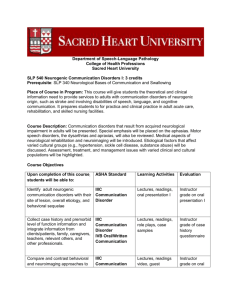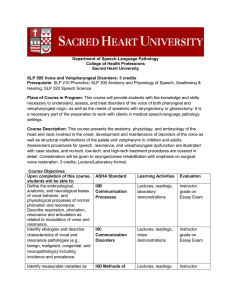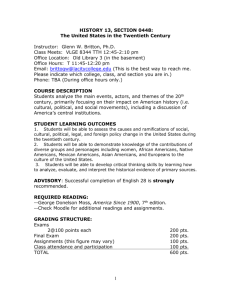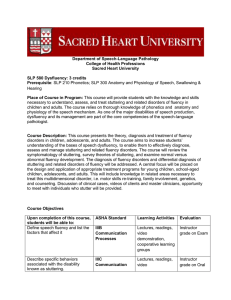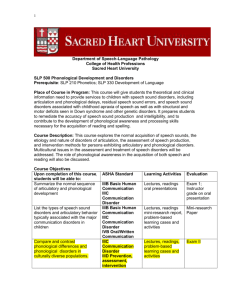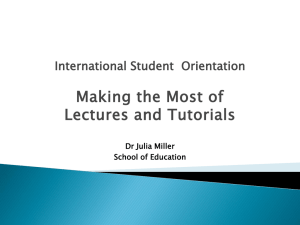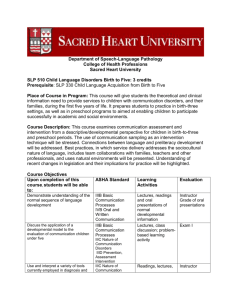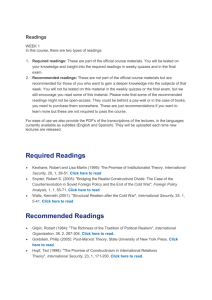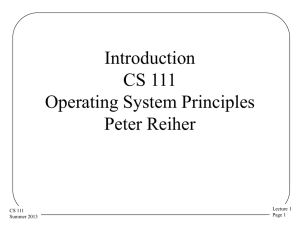SLP 699 Autism, AAC, and Severe Disorders of Communication: 3
advertisement
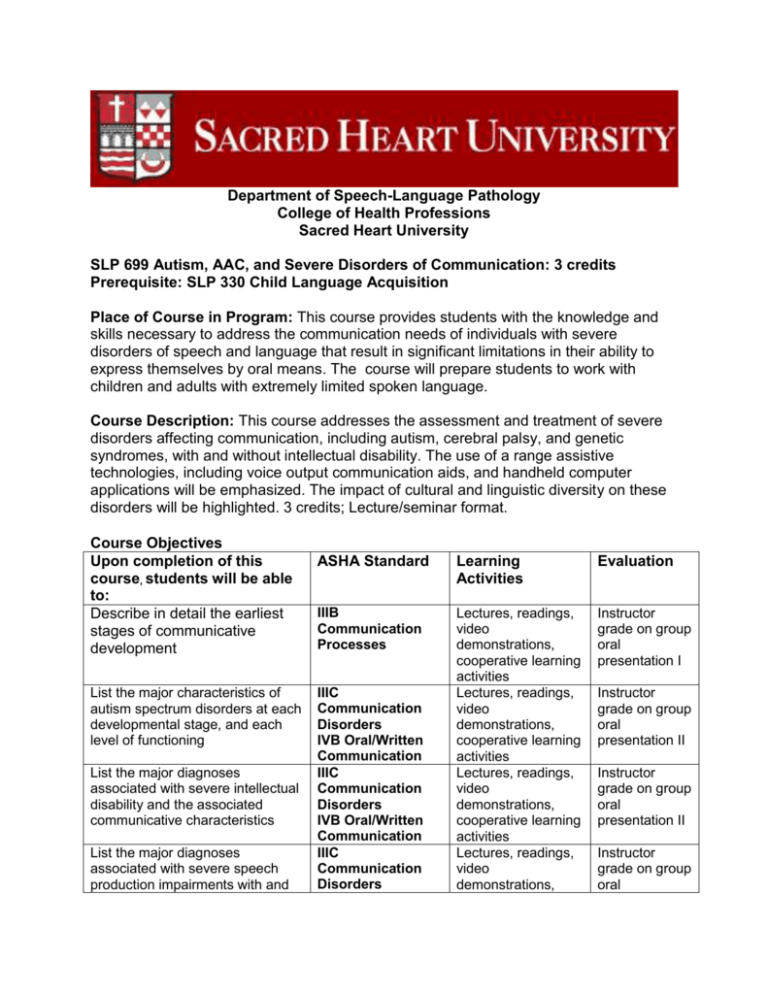
Department of Speech-Language Pathology College of Health Professions Sacred Heart University SLP 699 Autism, AAC, and Severe Disorders of Communication: 3 credits Prerequisite: SLP 330 Child Language Acquisition Place of Course in Program: This course provides students with the knowledge and skills necessary to address the communication needs of individuals with severe disorders of speech and language that result in significant limitations in their ability to express themselves by oral means. The course will prepare students to work with children and adults with extremely limited spoken language. Course Description: This course addresses the assessment and treatment of severe disorders affecting communication, including autism, cerebral palsy, and genetic syndromes, with and without intellectual disability. The use of a range assistive technologies, including voice output communication aids, and handheld computer applications will be emphasized. The impact of cultural and linguistic diversity on these disorders will be highlighted. 3 credits; Lecture/seminar format. Course Objectives Upon completion of this ASHA Standard Learning Evaluation course, students will be able Activities to: IIIB Lectures, readings, Instructor Describe in detail the earliest Communication video grade on group stages of communicative Processes demonstrations, oral development List the major characteristics of autism spectrum disorders at each developmental stage, and each level of functioning List the major diagnoses associated with severe intellectual disability and the associated communicative characteristics List the major diagnoses associated with severe speech production impairments with and IIIC Communication Disorders IVB Oral/Written Communication IIIC Communication Disorders IVB Oral/Written Communication IIIC Communication Disorders cooperative learning activities Lectures, readings, video demonstrations, cooperative learning activities Lectures, readings, video demonstrations, cooperative learning activities Lectures, readings, video demonstrations, presentation I Instructor grade on group oral presentation II Instructor grade on group oral presentation II Instructor grade on group oral without ID, and the associated communicative characteristics Describe and demonstrate the use of the major available forms of augmentative and alternative communication aids, both high and low-tech Enumerate and demonstrate an assessment protocol for identifying communication needs in a severely impaired client IVB Oral/Written Communication IIIC Communication Disorders IVB Oral/Written Communication IIID Methods of Prevention, Assessment, Intervention cooperative learning activities Lectures, readings, video demonstrations; problem-based learning activities Lectures, readings, demonstrations; case studies Discuss and demonstrate evidence-based methods for AAC intervention for individuals with severe communication disorders IIID Methods of Prevention, Assessment, Intervention IIIF Evidencebased practice IIID Methods of Prevention, Assessment, Intervention Lectures, readings, demonstrations; case studies; problem-based learning activities Lectures, readings, demonstrations; guest speakers, class discussion Reflective paper IIID Methods of Prevention, Assessment, Intervention IIIG Professional Issues IIIH Professional Credentials Lectures, readings, demonstrations; case studies; problem-based learning activities Reflective paper Compare and contrast the communication needs of individuals with severe communication disorders who are and are not in monolingual English environments Evaluate the role of the SLP in the multidisciplinary treatment of individuals with severe communication disorders, with special reference to integrating the individuals in mainstream academic, vocational, and recreational environments presentation II Instructor grade on individual oral presentation Instructor grade on assessment case study paper Instructor grade on intervention case study paper Readings Downing, J. (2005). Teaching Communication Skills To Students With Severe Disabilities -2nd Ed. Baltimore: Paul H. Brookes Course Requirements and Grading Criteria Assignments Points Group presentation I 20 Group presentation II 20 Oral presentation 10 Assessment case study 20 Intervention case study 20 Reflective paper 10 Total Possible Points 100 SHU Grade Criteria Letter Grade Grade Range Grade Points A 93-100 4.0 A90-92 3.67 B+ 87-89 3.33 B 83-86 3.00 B80-82 2.67 C+ 77-79 2.33 C* 73-76 2.00 C-* 70-72 1.67 D+* 67-69 1.33 D* 60-66 1.00 F 0-59 0.00 *Note: the following grades are not available for Graduate Courses: C-, D+, D Course Policies Academic Honesty: A standard of honesty, fairly applied to all students, is essential to a learning environment. Students abridging a standard of honesty must accept the consequences; penalties are assessed by appropriate classroom instructors or other designated people. Serious cases may result in discipline at the college or University level and may result in suspension or dismissal. Dismissal from a college for academic dishonesty, constitutes dismissal from the University.(University Student Handbook) Attendance and Class Participation: Students are expected to attend each class-attendance will be taken. Each student is expected to read assigned material prior to class and participate in class discussions. Students may be called on to answer questions and provide opinions during discussions. Students who miss class are responsible for content. Any student who misses a class has the responsibility for obtaining copies of notes, handouts, assignments, etc. If additional assistance is still necessary, an appointment should be scheduled with the instructor. Class time is not to be used to go over material with students who have missed class. Submission of work taken directly from another source (e.g. lesson plan copied from a book, the internet, or material developed by another student) will be considered plagiarism and grounds for no credit on the assignment. Students are encouraged, however, to use a variety of resources in obtaining ideas and illustrations that will help them complete assignments independently. See the APA Guide for the correct method to cite other authors' work. University policy dictates that students must seek the instructor's permission to record class lectures. All cell phones/pages must be turned off during class time. Students are required to show conduct consistent with professional standards as discussed in class when conducting on-site observations. Work done outside of class must be reasonably correct in mechanics (e.g. spelling, grammar, punctuation, etc.). Points will be deducted for inadequate work. All typed assignments completed outside of class must be double-spaced, using Times, Times New Roman, or Arial font. All font sizes for typed assignments must be size 11-12. Any font size less than 11 or larger than 12 will be returned for re-typing to required font size. APA style is required for written papers, including table, figure, and graph formats, references and citations, and appropriate professional language use. In ALL work, use person-first language to be consistent with IDEA. Emphasize the person more than the disability (i.e., a child with Down syndrome, NOT a Down syndrome child). Student work will be returned as promptly as possible. All assigned work is due at the beginning of class on the due date designated in the course syllabus. Work submitted late will receive an automatic 5-point reduction from the earned grade. Students are encouraged to submit all assignments on time. Competency: In this course, your knowledge will be assessed on the appropriate portions of the exams, or other assignments. Competency of 80% or better on these assessments is necessary to meet certification standards of the Council for Clinical Certification in Audiology and Speech-Language Pathology. Students failing to attain the set criteria on a required competency assessment will be provided a remediation plan and an additional attempt to pass the competency. If students do not pass the competency a second time, one additional remediation will be provided. For students failing to attain the set criteria on a required competency assessment after the third attempt, the department and university are not able to recommend their application for ASHA certification and state licensure, even though they may receive an acceptable course/clinic grade or exceed the minimum GPA. ADA Policy Students with disabilities needing academic accommodation should register with and provide documentation to Jandersevits Learning Center; no accommodations can be provided without written instructions from the Learning Center.
